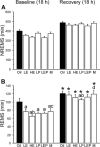Estradiol and progesterone modulate spontaneous sleep patterns and recovery from sleep deprivation in ovariectomized rats
- PMID: 19639749
- PMCID: PMC2704917
Estradiol and progesterone modulate spontaneous sleep patterns and recovery from sleep deprivation in ovariectomized rats
Abstract
Study objectives: Women undergo hormonal changes both naturally during their lives and as a result of sex hormone treatments. The objective of this study was to gain more knowledge about how these hormones affect sleep and responses to sleep loss.
Design: Rats were ovariectomized and implanted subcutaneously with Silastic capsules containing oil vehicle, 17 beta-estradiol and/or progesterone. After 2 weeks, sleep/wake states were recorded during a 24-h baseline period, 6 h of total sleep deprivation induced by gentle handling during the light phase, and an 18-h recovery period.
Measurements and results: At baseline and particularly in the dark phase, ovariectomized rats treated with estradiol or estradiol plus progesterone spent more time awake at the expense of non-rapid eye movement sleep (NREMS) and/or REMS, whereas those given progesterone alone spent less time in REMS than ovariectomized rats receiving no hormones. Following sleep deprivation, all rats showed rebound increases in NREMS and REMS, but the relative increase in REMS was larger in females receiving hormones, especially high estradiol. In contrast, the normal increase in NREMS EEG delta power (an index of NREMS intensity) during recovery was attenuated by all hormone treatments.
Conclusions: Estradiol promotes arousal in the active phase in sleep-satiated rats, but after sleep loss, both estradiol and progesterone selectively facilitate REMS rebound while reducing NREMS intensity. These results indicate that effects of ovarian hormones on recovery sleep differ from those on spontaneous sleep. The hormonal modulation of recovery sleep architecture may affect recovery of sleep related functions after sleep loss.
Figures






Similar articles
-
Female reproductive hormones alter sleep architecture in ovariectomized rats.Sleep. 2011 Apr 1;34(4):519-30. doi: 10.1093/sleep/34.4.519. Sleep. 2011. PMID: 21461331 Free PMC article.
-
Ovarian hormones promote recovery from sleep deprivation by increasing sleep intensity in middle-aged ovariectomized rats.Horm Behav. 2013 Apr;63(4):566-76. doi: 10.1016/j.yhbeh.2013.02.011. Epub 2013 Feb 27. Horm Behav. 2013. PMID: 23454003
-
Estradiol suppresses recovery of REM sleep following sleep deprivation in ovariectomized female rats.Physiol Behav. 2011 Oct 24;104(5):962-71. doi: 10.1016/j.physbeh.2011.06.016. Epub 2011 Jun 23. Physiol Behav. 2011. PMID: 21722658 Free PMC article.
-
Counterpointing the functional role of the forebrain and of the brainstem in the control of the sleep-waking system.J Sleep Res. 2004 Sep;13(3):179-208. doi: 10.1111/j.1365-2869.2004.00412.x. J Sleep Res. 2004. PMID: 15339255 Review.
-
Neuro-orchestration of sleep and wakefulness.Nat Neurosci. 2023 Feb;26(2):196-212. doi: 10.1038/s41593-022-01236-w. Epub 2022 Dec 29. Nat Neurosci. 2023. PMID: 36581730 Review.
Cited by
-
Different temporal relationship between sex hormones and sleep status in midlife women: a longitudinal cohort study.Sex Med. 2025 Mar 2;13(1):qfaf009. doi: 10.1093/sexmed/qfaf009. eCollection 2025 Feb. Sex Med. 2025. PMID: 40041303 Free PMC article.
-
Increasing of Cortisol Level and Neutrophil-Lymphocyte-Ratio are Associated with Severity Level and Sleep Disturbances in Acute Ischemic Stroke.Int J Gen Med. 2023 Nov 22;16:5439-5448. doi: 10.2147/IJGM.S439149. eCollection 2023. Int J Gen Med. 2023. PMID: 38021057 Free PMC article.
-
Role of Ovarian Hormones in the Modulation of Sleep in Females Across the Adult Lifespan.Endocrinology. 2020 Sep 1;161(9):bqaa128. doi: 10.1210/endocr/bqaa128. Endocrinology. 2020. PMID: 32735650 Free PMC article. Review.
-
Disruption of Sleep Continuity During the Perimenopause: Associations with Female Reproductive Hormone Profiles.J Clin Endocrinol Metab. 2022 Sep 28;107(10):e4144-e4153. doi: 10.1210/clinem/dgac447. J Clin Endocrinol Metab. 2022. PMID: 35878624 Free PMC article.
-
Estradiol influences adenosinergic signaling and nonrapid eye movement sleep need in adult female rats.Sleep. 2022 Mar 14;45(3):zsab225. doi: 10.1093/sleep/zsab225. Sleep. 2022. PMID: 34477210 Free PMC article.
References
-
- Dzaja A, Arber S, Hislop J, et al. Women's sleep in health and disease. J Psychiatr Res. 2005;39:55–76. - PubMed
-
- Moline ML, Broch L, Zak R. Sleep in women across the life cycle from adulthood through menopause. Med Clin North Am. 2004;88:705–36. - PubMed
-
- Polo-Kantola P, Erkkola R, Helenius H, Irjala K, Polo O. When does estrogen replacement therapy improve sleep quality? Am J Obstet Gynecol. 1998;178:1002–9. - PubMed
-
- Montplaisir J, Lorrain J, Denesle R, Petit D. Sleep in menopause: differential effects of two forms of hormone replacement therapy. Menopause. 2001;8:10–6. - PubMed
Publication types
MeSH terms
Substances
LinkOut - more resources
Full Text Sources
